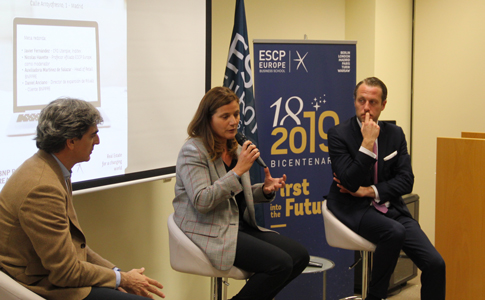ESCP and BNP Paribas Real Estate held their first event within the framework of the “Advanced Program in Real Estate”, which has recently begun its activity. It highlighted the idea of understanding the retail segment in a more creative and open way.
The round-table was moderated by ESCP Affiliate Professor Nicolas Havette, and attended by Uterqüe, Inditex CFO Javier Fernández, BNP Paribas Real Estate (Spain) Head of Retail Auxiliadora Martínez de Salazar, and Rituals Director of Business Development Daniel Anciano.
The event, which took place on April 25 at the school's Madrid campus, highlighted the idea of understanding the retail segment in a different way. Speakers agreed that it is constantly evolving and far from disappearing. Spanish retail still accounts for 90% of current sales in stores (only 10% correspond to online sales). Among online retailers, only 12% are currently profitable.
Although retail operators speak about “multi-canals”, according to Javier Fernández the line separating them is becoming thinner and there is more talk of hybrid sales. In other words, sales can come through any channel.
Retail becomes a shopping experience
"When you talk about sales, you have to understand that this process doesn't start in the store," says Javier Fernández. "When a customer comes into the store, he already knows the brand," adds Daniel Anciano. When we talk about continuous experience, we talk about all the inputs that the customer receives from the moment he comes in until he leaves, from the decoration part to the product test, through the employee who attends him and the treatment he receives.
Speakers also highlighted the importance of generating a story-telling around the brand: when a customer comes into the store, he or she is imbued with the brand philosophy.
Shopping malls are changing
Shopping malls is a clear example of how the retail segment is changing. Anciano points out once again that customers are no longer interested in strolling through long corridors and streets full of white lights. Customers want an “experience”, and in this particular case owners should bet on retailers that offer something different.
Variable income rentals
 For Javier Fernández, it is important that rentals start to change and move to variable income rentals. For Fernández, it is one of many proposals within the new possibilities that we will have to confront in the coming years and an example of a change of mentality in the sector. It is also another way of sharing risks with landlords. Another example, he continues, would be to study the possibility of including clauses on the part of lessors that affect online sales in the leased premises. “It will be important to keep an open mind to change and to be creative in the way we understand business and property relations in a market that is increasingly stressed by promotional activity and its impact on margins,” he says.
For Javier Fernández, it is important that rentals start to change and move to variable income rentals. For Fernández, it is one of many proposals within the new possibilities that we will have to confront in the coming years and an example of a change of mentality in the sector. It is also another way of sharing risks with landlords. Another example, he continues, would be to study the possibility of including clauses on the part of lessors that affect online sales in the leased premises. “It will be important to keep an open mind to change and to be creative in the way we understand business and property relations in a market that is increasingly stressed by promotional activity and its impact on margins,” he says.
The configuration of the streets is also changing and the sector must understand that there is a different way to work. Because the market is evolving, local vacuums may begin to form in prime areas, as we are now observing in New York's 5th Avenue. This fact has to do not only with rentals but also with the fact that the entry barrier of being present in the street has fallen. “We no longer run the risk of making unprofitable flagships,” notes Anciano. Even the street itself is no longer a destination in itself - or at least not the only one -, in favour of other areas and other players, as in the case of Soho in New York.
Campuses